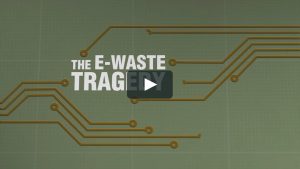– and the UK is one of the worst offenders.
Make all electronic items recyclable and offer easy ways to do it, such as doorstep collection.
.

What goes into your mobile phone or laptop?
Some would call them ‘conflict minerals’:
Futures Forum: Conflict minerals in your gadgetry > the blood and sweat in phones and batteries
We can try recycling them:
Futures Forum: Recovering conflict minerals
And this news blog has already looked at possible ways ahead:
Turning e-waste into opportunities
E-waste: recover, recycle, redistribute and reuse
.
Today, Aleksandra Wisniewska writes in the FT (reproduced in the i newspaper) – with excerpts here:
.
What happens to your old laptop? The growing problem of e-waste
…
E-waste is the fastest-growing element of the world’s domestic waste stream, according to a 2017 report by the UN’s Global E-waste Monitor. Some 50m metric tonnes will be produced annually this year — about 7kg for every person in the world. Just 20 per cent will be collected and recycled.
The rest is undocumented, meaning it likely ends up in landfill, incinerated, traded illegally or processed in a substandard way. That means hazardous substances spilling into the environment, poisoning the ground and people living nearby.
“Once e-equipment becomes waste, it is hazardous. If you just dumped it in the environment, it would cause a problem,” says Richard Kirkman, chief technology and innovation officer at Veolia. Kirkman has spent the past 20 years working in the waste sector, and has amassed knowledge about seemingly every recycling process out there. But when he started, he says, everything was going to landfill. “Things have got much better [over time].”
Heavy metals such as mercury, lead and cadmium — commonly found in LCD screens, refrigerators and air-conditioning units — as well as chemicals such as CFCs and flame retardants found in plastics can contaminate soil, pollute water and enter the food chain.
Research last year by Basel Action Network, an NGO, linked toxic e-waste shipped from Europe to contaminated chicken eggs in Agbogbloshie — a Ghanaian scrapyard where 80,000 residents subsist by retrieving metals from electrical waste. Eating just one egg from a hen foraging in the scrapyard would exceed the European Food Safety Authority’s tolerable daily intake for chlorinated dioxins 220-fold.
These toxic substances mean that defunct electronics are designated hazardous waste by the EU, which bans exports of this kind to non-OECD countries. But the European Environment Agency estimates that Europe still illegally exports 1.3m tonnes of e-waste each year.
An investigation in 2019 by Basel Action Network found that the UK is the worst offender in Europe for illegal e-waste exports to developing countries, with most of its load going to Africa.
‘Uber for trash’
The e-waste problem in the UK is particularly bad. The country produces 24.9kg a person a year — nearly 10kg more than the EU average, according to a recent report from the Environmental Audit Committee. In 2018, 1.2m tonnes of electrical devices were sold in the UK, and 500,000 tonnes made it to recycling centres.
Some appliances are more likely to be recycled than others. The recycling rate for big appliances, such as fridges and cookers, is about 80 per cent. That is because they are harder to dispose of and eventually get picked up, even when they are dumped by the kerb. Of small appliances, however, barely one in five makes it to the recycling centre.
Because items such as toasters and hairdryers fit into household bins, more often than not it is easier to chuck them than to take them to a recycling centre or arrange collection from the council over the phone. The challenge, says Kirkman, is to make all electronic items recyclable and offer easy ways to do it, such as doorstep collection.
….
What happens to your old laptop? The growing problem of e-waste | ft.com